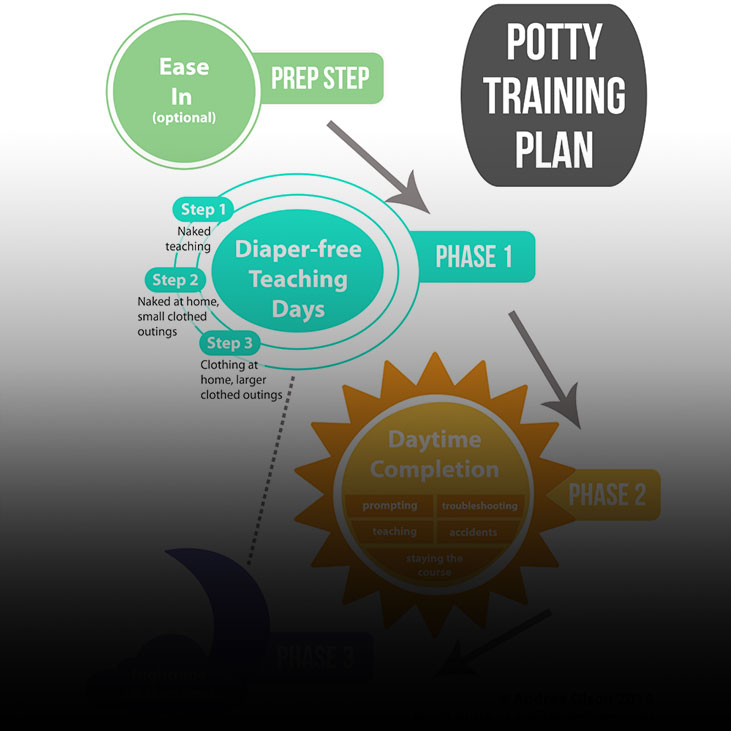Potty Training
Did you know?
- The average age of potty training has nearly tripled since the invention of disposable diapers.
- Training EARLIER is easier! Kiddos get more willful as they get older, so 12-18 months tends to be the golden window
- The US sends approximately a half MILLION elephants worth of disposable diapers to the landfill EVERY YEAR.
Check out the Potty Training info below, and let us know any other questions you have!
Want to read about baby pottying, instead?
The Potty Training Experience
Choose a time when you have a few days you can commit to this. Every child is different, but if you stick with it, most children complete in 7-10 days. The first day or two you want to commit to STAYING HOME. Turn off the devices. Turn off the TV. Pay attention to your child. If you have multiple children, consider having someone visit to help you, but only if that person is someone who will HELP, but not distract you. It can seem a little daunting, but honestly, most of us would benefit from a couple of tech-free days, and you are teaching your child a very important skill.
The first part is pants-free time at home. No diaper, no undies—nothing. Use a long shirt or dress if modesty is a concern. If it’s cold, leg warmers or chaps are a good choice. The reason for pants-free time is that since the child has spent all their life so far in diapers, most kids have not had the opportunity to connect the dots between the need to pee and the result. It’s all happened in their diaper, and they often need that connection of, “OH! That’s what this feeling means!”
Do this in a room without carpet, or put down mats, or spend the day outside! Whatever you need to do so you don’t have to worry about pee on your floor.
So no pants, and tell them, “Pee goes in potty now.” For this first part, try not to prompt them to go potty. You want to observe them, see if you notice a pee-pee dance, make note of how often they naturally go, etc. It’s fine to toss out some reminders “Pee goes in the potty now,” but don’t PUT them on the potty unless they are actually going, or they are clearly doing the potty dance/poop dance about to go.
Every single time he begins to pee, you will calmly transport him (lift him up off the ground and onto the potty or into the bathroom) onto the potty and say “pee in potty.” Even if you’ve only gotten one drop in (and a trail of drops behind you), it counts!
It is essential to only put her on the potty DURING a pee or poo. Putting her on the potty at random times throughout the day teaches nothing.
The physical act of getting on the potty only while eliminating is what teaches. Having them “practice sitting” doesn’t teach them what it’s for.
But actually demonstrating it through the body itself? THAT is what teaches this.
So, there’s a line of progress you want to move along. I peed — I’m peeing — I need to pee. ANY progress along this path counts! Once they are showing some progress along it, you can move to step 2, which is to put on a pair of pants or shorts and go for a short walk. Like 5-15 minutes, depending on how long they normally go between peeing. No diaper, no underwear, just pants or shorts. This prevents them from feeling like they’re in a diaper. Take the walk (leave right after a pee), then come home, and pants back off. You can do this several times. This gives the child a chance to successfully go out and stay dry.
Once you’ve had several successful outings, you can move to step 3, which is commando under shorts or pants at home, and then undies and shorts/pants for outings, with the outings getting longer and longer.
There is no set amount of time to spend on each step; just whatever seems right for the child.
Use these days to also teach skills like getting ON the potty, wiping, flushing, washing hands, etc. Anything the child CAN do, let them be the one to do it. They will be less resistant when they are given control of the situation. Toddlers want to have control of their own life, same as any of us. By teaching them the skills and letting them do what they can, we are helping them gain an important independence.
Once you’ve gotten past the first few days, it’s fine to put them on the potty at good opportunities, like in/out of the car, in/out of highchair, or other normal transition times when you would normally go, or when you would have older children go. It’s just the first little bit of helping them learn to recognize the need to go that you want to only put them on when they ARE going.
Night-time/naps is a whole different conversation, so we’ll leave it at this for now, with just one thing on sleep - as soon as they wake up, diaper goes away, and sit on potty. Most humans will need to go right after waking up, babies and children included!
At a Glance
Check back soon for more!


